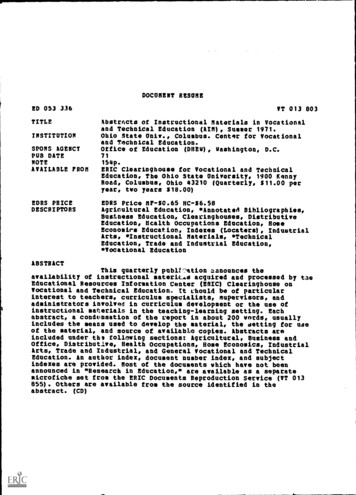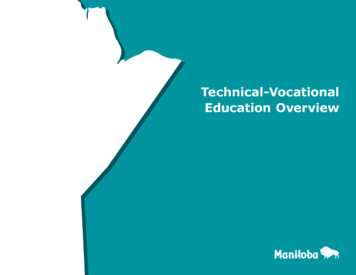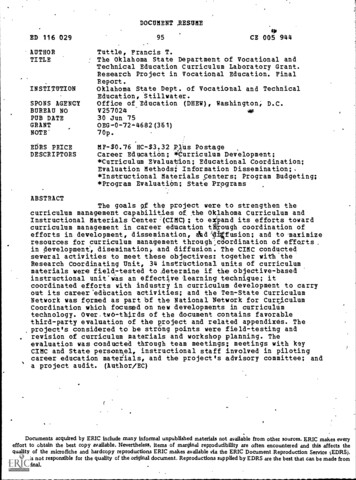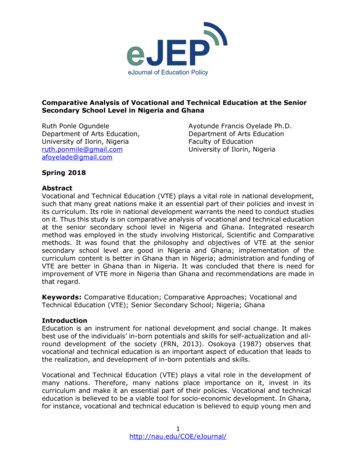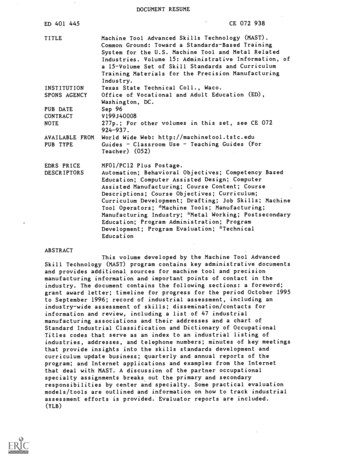
Transcription
Education Learning andDevelopment ModuleTECHNICAL AND VOCATIONALEDUCATION AND TRAININGFoundation Level2020
Technical and Vocational Education and Training – FOUNDATION LEVELCONTENTSAcronyms . 31Introduction . 42What is TVET and why is it important? . 43Current status of TVET in Developing Countries . 74How are partner governments improving TVET . 115The Role for Australia and Other Donors . 176Test your knowledge. 20References and links. 242
Technical and Vocational Education and Training – FOUNDATION LEVELACRONYMSADBAsian Development BankAPTCAustralia Pacific Training CoalitionCEDAWConvention on the Elimination of All forms of Discrimination Against WomenDFATDepartment of Foreign Affairs and TradeGNPGross National ProductILOInternational Labor OrganizationNQFNational Qualifications FrameworkTVETTechnical and Vocational Education and TrainingPNGPapua New GuineaPRCPeople’s Republic of ChinaUNESCOUnited Nations Educational, Scientific and Cultural Organization3
Technical and Vocational Education and Training – FOUNDATION LEVEL1 INTRODUCTIONThe purpose of this module is to provide introductory information Technical andVocational Education and Training (TVET), outlines the case for investment and provideseffective strategies to strengthen TVET investments. It provides a foundation to engage inthis topic and apply advice from staff with operational or expert levels of knowledge ineducation. On successful completion you will be able to be an informed participant inforums related to TVET.2 WHAT IS TVET AND WHY IS ITIMPORTANT?An activity for youConsider the following scenario.You participate in a discussion on the high unemployment andlow productivity rates of the partner country you are workingwith.The following are some of the statements made by attendees. ‘Productivity and incomes will not increase unless firms put more money intotraining their workforce.’ ‘Nobody’s teaching entrepreneurial skills.’ ‘The high number of unemployed youth will lead to problems in the future.’ ‘There should be more adult courses for people in the informal sector.’ ‘Colleges and the professions aren’t getting the right students.’ ‘Even with high unemployment rates, there are gaps in the nationalworkforce, and migrant labour is needed.’ ‘Schools don’t provide the skills needed by the labour market; they shouldteach more practical courses.’ ‘Graduates skills don’t match up with workplace needs and requirements.’ ‘Women aren’t strong enough for some professions.’You are asked whether you think there should be more emphasis on TVET.Which of the statements above are talking about TVET and which aren’t?4
Technical and Vocational Education and Training – FOUNDATION LEVELWhat is TVET?TVET terminology tends to be used loosely. Terms ‘TVET’, ‘Vocational Education’ and‘Vocational Education and Training (VET)’ are often used interchangeably, with variousdevelopment partners and countries using different terms. Australia primarily uses VETdomestically. Increasingly, Australia’s overseas development investments use ‘skills’reflecting TVET’s contribution beyond learning to productive employment, sustainablelivelihoods and economic growth. Regardless of what the sector or training is called, TVET isinherently practical and can be broadly understood as ‘the acquisition of knowledge andskills for the world of work’.Source: UNESCO-UNEVOC 2017, What is TVET?TVET programs can be delivered as a formal qualification within a national training system.Such formal education and training: takes place in or involves the system of schools, colleges and universities andother formal education institutions constitutes a continuous ladder of education is directly relevant for the highest level of formal education attained.Or, TVET can be delivered through non-formal education and training. These either do notlead to qualifications, or lead to a certificate of completion or similar qualification which isnot directly recognised by relevant national education authorities.Formal and non-formal TVET is also distinguished from informal learning or random learningwhich are not institutionalised, such as self-directed learning, coaching or networking.TVET education, training and skills development takes place at a number of levels and relatesto a wide range of occupational fields, production, services and livelihoods:‘TVET, as part of lifelong learning, can take place at secondary, postsecondary and tertiary levels and includes work-based learning andcontinuing training and professional development which may lead toqualifications. TVET also includes a wide range of skills developmentopportunities attuned to national and local contexts. Learning to learn,the development of literacy and numeracy skills, transversal skills andcitizenship skills are integral components of TVET’.Source: UNESCO, 2015, TVETipedia Glossary.In practice, TVET might be delivered through: Craft and business courses in general secondary schools (and in some cases,primary schools) or in vocational secondary schools. Vocational education and training at the tertiary level (notably in technicalcolleges and tertiary level vocational education). Adult vocational training for employees, those seeking employment and those5
Technical and Vocational Education and Training – FOUNDATION LEVELsetting up businesses, particularly in the informal sector.Table 1 – Some examples of TVET provision and involved partnersAspect of TVETTechnicalEducationVocationalEducationFormal ur and SocialAffairs or AdultEducationTVEToversight andgovernanceMinistry ofEducationMinistry ofEducationNational TrainingCommissionPurposeProvide skilledtechnicians for theworkforcePrepare schoolstudents for theworld of workProvide job-ready skills for thoseentering the workforce, and improveskills of those seeking employmentTrainerGovernment ornon-governmenttechnical collegeCertificate in ICTsystems supportGeneralsecondary schoolTVET college(public or private)Adult educationcentreFashion designCertificate cate incomputer aideddesignCertificate 2:Heavy plantoperationLight vehiclemaintenanceWhy is TVET important?TVET has multiple benefits to an individual, an employee and a nation. It strengthensindividual skills and employability, builds employer capacities leading to higher revenueand increases productivity in a nation which can contribute to a more competitiveeconomy and economic growth. TVET also has returns to society, including improvedhealth, social cohesion through increased democratisation and human rights, and bettersocial equity particularly for disadvantaged groups and strengthened social capital.Benefits for the individual Possession of skills to undertake new tasks and move up the career ladder. Improved access to local, regional and international labour markets, especiallyfor young people. Enhanced ability to financially support themselves and their family to improveliving standards, especially engagements through the informal sector.Benefits for employers Increased motivation of employees leading to higher revenue. Higher standards of production or service provision leading to increased qualityservices.6
Technical and Vocational Education and Training – FOUNDATION LEVEL Reduced number of accidents in the workplace.National benefits of investing in TVET Increased employment for women and men, and associated social and economicbenefits including poverty reduction. Reduced threats of crime and national security from disaffected or unemployedpersons. Addressing skill gaps that are hindering economic growth and service provision,while reducing the need for migrant labour who remit currency and profitoverseas. A national workforce that can compete in international job markets, withpotential to return remittances and profits.3 CURRENT STATUS OF TVET INDEVELOPING COUNTRIESAn activity for youConsider the following scenario.You are part of a small group visiting a technical college todiscuss the need to improve training provision in the countryconcerned. At the last minute, you learn that the TVET expert cannot join you. You willstill be expected to provide some information on the state of training provision at thiscollege.What should you look out for, and what questions should you ask during thetechnical college visit?Try answering this question again after reading the next section on ‘Problems withTVET provision’.Problems with TVET provisionThe education and training capacity of most low-income countries have greatly expandedover the last few decades with increasing primary school participation, but TVET has oftennot kept pace, maintaining low enrolment numbers and not improving quality delivery.Some reasons for this are discussed below.7
Technical and Vocational Education and Training – FOUNDATION LEVELFigure 1 – Barriers to quality TVETEquipmentshortagesPoor inclusionWeakcoordinationand qualityassuranceLow statusShortage ofqualitytrainersLowQualityTVETLow relevanceof trainingRapid growthin s andindustriesEquipment shortagesTVET resourcing, which requires industry standard equipment and materials, typicallyinvolves a much higher cost and complexity than those needed for basic education.Limited education budgets means that TVET training in developing countries often relieson theoretical or classroom teaching, or demonstration and written work rather than onpractical skills development. For example, public TVET trainers might offer automotivetraining, but not have any automotive tools. Students would be shown pictures of thetools, rather than how to actually use them.Shortage of quality trainersA quality TVET trainer needs both up to date industry experience in the relevantoccupational field, and the ability to teach. Too often, initial training and ongoingprofessional development of TVET teachers is absent. As a consequence, TVET is oftentaught by: a general teacher with little knowledge of the relevant trade or occupation, andtherefore with limited experience troubleshooting technical processes andtechniques a person who worked in the profession many years earlier, who is unfamiliar withthe latest developments in the respective industry and workplaces a newly trained person, with limited practical industry or teaching experience somebody with a background in the occupation but with no teacher or instructortraining.Rapid growth in student numbersA bulge in student numbers in primary schools naturally results in greater demand for8
Technical and Vocational Education and Training – FOUNDATION LEVELsecondary and tertiary level education and training. This situation is exacerbated in IndoPacific countries with a rapidly growing youth bulge. Rapid growth, combined withshortages of TVET trainers, equipment and funds, can lower the quality of vocational andtechnical provision.Limited fundingThere are high operational costs associated with good quality TVET provision, coupled withthe ever-present competition for public and private resources and low levels ofgovernment and enterprise funding for TVET. When teamed with limited recurrent andnon-recurrent funding, this can constrain system effectiveness and quality.Low budgets are compounded by inefficiencies in how funds are spent, shortages ofequipment, materials, staffing problems and ineffective management.But interest in TVET is now increasing, particularly in countries with high and rapidlygrowing youth populations.Disconnect with employers and industriesThe interaction between the industry and institution is now widely recognised as anessential requirement to train and develop the right kind of work force necessary forsustaining and promoting industrial and economic growth.In most developing countries, links with industry are not systematic and the supply ofskilled workers falls a long way short of demand: in quantity, in the match of skills to jobsrequired, and in the quality of skills. TVET training is often a supply-driven skills system:people are trained with limited consideration of the demands of prospective employersand the skills needed in today’s workplaces.A more successful skills system provides a good match between skills demand andgraduate supply as conditions in the labour market continue to evolve. Such a matchrequires ongoing and meaningful engagement between training institutions, accreditationbodies and key employer and industry groups. There should also be a firm view of labourmarket requirements and future areas of growth.Low relevance of trainingMany training institutions find it very difficult to keep up with the rapid changes intechnology and the labour market and processing changes including: understandingchanges; developing new courses based on changing competency requirements; andretraining staff and acquiring new equipment. The result is to reinforce providers’tendency toward supply-driven program offerings, which further undermines their abilityto respond to employers’ needs.Weaker training systems do not provide guidance on industry training requirements or linktraining to the nation’s economic demands. TVET providers are hard pressed tounderstand and then satisfy the expectations of employers. Employers in turn can distancethemselves from the providers, further weakening the relevance of training offered.Employers can also be a major source of formal and non-formal skills delivery, both in9
Technical and Vocational Education and Training – FOUNDATION LEVELproviding workplace training as well as opportunities for apprenticeship or workplacements. This can be an important mechanism for developing work-ready skills, and toimprove the relevance of training.Low statusIn many countries, schools and their students as well as parents often focus attention onthe academic pathway through secondary education and onwards to university. Anythingelse is often seen as second best. Young people are often not informed that TVETgraduates can command high salaries, especially in high demand sectors or advancedeconomies. Those entering vocational secondary schools or technical colleges tend to beseen to be the lower achievers in education.TVET’s status can contribute to low morale, low expectation from trainers and trainees,and thus leading to low standards.Weak coordination and quality assuranceTVET systems are complex. Often TVET systems have a wide range of courses, providersand ministerial involvement, coupled with weak systems for planning and monitoring,financing and management. In such cases, accountability, oversight and quality assurancesystems may be unclear, unevenly applied and with limited incentives for goodperformance.A key component of improving the quality of TVET institutions is to streamline theregulatory environment. Requiring an investment in coordination, systems of qualityassurance and accountability at sectoral and institutional levels in order to function well.Poor inclusionTVET tends to have more selective access, participation and graduates than generaleducation. There tends to be much lower numbers of female TVET students, particularly in‘traditional’ male-dominated areas (e.g. building trades). There may be significant accessand participation barriers for many people in rural areas, disadvantaged communities andpeople with disabilities.TVET’s informal learning models can address existing inequities in the education system.TVET offers an effective way to draw in those with limited experience in the educationsector, and to build technical and literacy and numeracy skills at the same time. Specificinvestments for equity groups will ensure nations benefit from all of TVET’s possiblereturns on investments.10
Technical and Vocational Education and Training – FOUNDATION LEVEL4 HOW ARE PARTNER GOVERNMENTSIMPROVING TVETAll governments acknowledge the contribution of a skilled workforce to a productive andgrowing economy. The following diagram below shows some of the ways that the partnergovernments supported by Australia are tackling challenges in their TVET systems.Figure 2 – Government actions for strong TVET trainersFocus itationSectoral coordinationMany countries have set up national training council’s or similar agencies to ensure thetraining system provides standardised qualifications. Training Councils can forecast andrespond to the knowledge and skill sets that industry needs, currently and into the future.Examples include the Vanuatu Qualifications Authority and the Tonga NationalQualifications and Accreditations Board. These bodies bring together staff of governmentministries. In some cases they are autonomous bodies with industry supplying some of thedirectors. Sometimes there is a network of subsidiary provincial agencies (e.g. the NationalEmployment Agency in Cambodia).Sources: Vanuatu Qualifications Authority 2020, Tonga National Qualifications and Accreditations Board2020.Focussing on demandCountries with strong TVET systems prioritise meeting industry demand and identifying11
Technical and Vocational Education and Training – FOUNDATION LEVELpriority skills. They often use labour market surveys to forecast economic and labourmarket changes. Signals from jobs analysis, from advertised job opportunities and fromstakeholder feedback may be used to assess the demand for different skills. Singapore andSri Lanka have demand led skills systems that use state-directed industrial policy andhuman development planning as part of national planning for industry and commerce.A good practice example can be found through the Australia Pacific Training Coalition(APTC), the Australian Government flagship program for TVET in the Pacific. APTCundertakes detailed skills gap assessments in each of its campus countries (Fiji, PNG,Samoa, Solomon Islands and Vanuatu) through an annual Environmental Scan, industryconsultations, labour market analysis and graduate employment outcomes monitoring toinform its course planning. These documents can be found on the APTC website.Source: APTC 2019.National Qualifications FrameworksIt is the role of National Qualifications Frameworks (NQFs) to structure and regulate TVETqualifications against agreed quality assurance measures such as occupational standards.Sector or Industry Working Groups develop the national qualifications for differentindustrial sectors, with appropriate representation from relevant industry, profession orcommunity stakeholders.NQFs identify equivalence standards for qualifications, allowing links between TVET,general education qualifications (e.g. school certificates) and higher education. An NQFtypically shows pathways for progression from one course to a higher-level course. Suchpathways can help overcome some of the status problems for TVET. Ideally NQF covers allaccredited qualifications delivered in a country, whether delivered by a government orprivate training provider, but often countries run separate systems for public and privateeducation.12
Technical and Vocational Education and Training – FOUNDATION LEVELCase study: Papua New Guinea Government-ledReformA recent whole of sector case study comes from Papua NewGuinea, where responsibility for post-secondary educationhad been spread across nine different national departmentsand agencies and further fragmented at sub-national level. This led to inefficienciesand made national policy difficult to implement.From 2017, Australia’s technical support to the Department of Higher Education,Science, Research and Technology focused on supporting a Government of PNG-ledchange management process. The reform initiated a National Skills DevelopmentAgency to link skills training to industry demand, established a single nationalqualifications framework and transferred all post-secondary institutions to theoversight of a single ministry that of Higher Education, Science, Research andTechnology.Source: PNG 2019.To be effective, an NQF requires strong enforcement to achieve expected qualityassurance and accountability standards.Course registration and accreditationA formal TVET program is one that is registered by a government regulatory authority. Theregistration process provides quality assurance, ensuring the program meets minimumstandards in its courses and the teaching environment (e.g. qualified staff with adequatefacilities). Registration should require an inspection that is repeated after a set interval.Some national bodies (e.g. the Philippines Technical Education and Skills DevelopmentAuthority) have a system of accrediting course providers that significantly exceed thecompulsory minimum requirements for registration. This requires the institution to haveits own Institutional Quality Assurance System in place.Source: Philippines Technical Education and Skills Development Authority 2020.Adequate resourcesPublic (and sometimes private) training programs receive funds from governmentbudgetary appropriations for technical and vocational education. Many TVET level traininginstitutions charge fees, in part because of funding shortfalls, and in part because a TVETqualification is often perceived as accruing private benefits to trainees (i.e. higher futureearnings as a result of the training). Fees can represent a significant resource for privateinstitutions. Because fees can hinder access by poorer students, governments sometimesoffer scholarships, particularly to encourage some disadvantaged groups into education(such as those with a disability) or to incentivise enrolment in priority courses to meet13
Technical and Vocational Education and Training – FOUNDATION LEVELidentified labour market shortages.Besides course fees, additional funding may accrue from:1. A national training fund: Some countries, such as Samoa, Tonga and Vanuatu, haveestablished a national training fund. This can pool funds from various sources,including donor funds, and can be disbursed to support national priority areas, forexample training for the unemployed and for the informal sector.2. A national training levy: Countries including Malaysia support national trainingthrough a national training levy. This is a tax on companies with payrolls above aspecified level. A national training levy supports training by allowing firms to offsettheir own training provision against the tax. Training levies can be collected andtargeted within an occupational grouping (for example, in Kenya a tax on hotel billsis used to fund training for the tourism sector).3. Market contributions: Training providers can sometimes secure marketcontributions – funding directly or in-kind from industry and the private sector. Thissometimes includes the loan or donation of equipment or experts. Colleges cangenerate income by selling goods or services to industry, including speciallydesigned training programs, outputs from lessons (such as furniture, stoves orcreating COVID-19 face masks), commercial testing and research and development.Competent trainersA few countries have introduced specific training programs for TVET teachers and trainers,including, for example, Fiji and Samoa. This includes upgrading their technical expertise,especially in relation to new technologies and skills, and providing instructor effectivenesstraining.There are often systemic challenges to trainer competence. In some countries, TVETtrainers are required to have full teaching qualifications which means it is hard to recruit orretain qualified staff. In PNG for example, TVET trainers have been required to have a fouryear teaching degree in order to be employed as public servants. This has meant that therequirement for industry competence is often not enforced. It is also challenging fortrainers to maintain industry currency and relevance once they have commenced,particularly public sector trainers who may not be released to undertake industryimmersions.Equity measuresThe high user costs of TVET are a major problem for poorer communities. Somegovernments provide merit-based scholarships for students from poorer communities.Development interventions are a powerful avenue to drive improvement to access forwomen, people with disabilities and marginalised groups in TVET. Development partnerscan also help to even the playing field by support that helps people facing barriers to skillseducation into TVET institutions.This aligns to the legislation against discrimination and for supporting equal opportunitiesfor all that most countries have committed to. Examples of supportive policy include:14
Technical and Vocational Education and Training – FOUNDATION LEVEL The Convention on the Elimination of All forms of Discrimination Against Women(CEDAW) (1979). The Beijing Declaration and Platform for Action (1995) stresses the need forwomen’s equal access to education training and employment. International Labor Organization (ILO) Conventions 100, 111, and 142 provide theinternational normative framework for gender equality with respect to access tovocational training opportunities. Sustainable Development Goal 4 (2015) includes a target of ensuring access forall women and men to affordable and quality TVET.Sources: UNHCR 1979, UN 1995; 2015, ILO 2017.Gender equality in TVET is usually monitored and reported on as part of an overallcommitment to gender equality in education.The APTC has successfully addressed inclusion by specifically allocating places for womenon courses in traditional male dominated trades, mentoring female trainers to lead tradeclasses and supporting female-led networking initiatives. APTC’s Gender and SocialInclusion Strategic Framework outlines steps to develop a more skilled, inclusive andproductive workforce to enhance Pacific prosperity. The Kiribati Skills for Employmentprogram also targets inclusion by supporting female graduates to establish their ownbusiness in traditional male dominated trade areas through a business incubator.Some programs are geared to helping women and people with disability enter theworkforce by offering training closer to their homes, and with inclusion-focusedinfrastructure, facilities and training approaches (for example the Tonga and Sri Lankan‘Skills for Inclusive Economic Growth’ programs).Sources: UN 1978, UN 1995, UN 2019, ILO 2019, DFAT 2014, DFAT 2016, DFAT 2018.An activity for youRead the case study and answer the following question.How have some of the barriers against TVET for women beenovercome in the case study?15
Technical and Vocational Education and Training – FOUNDATION LEVELCase study: Educating women in non-traditionaltradesGail Waki teaches masonry and tiling - she is a rare breed inVanuatu a woman in a traditionally male dominated trade. Allbut one of her TVET students at the Vanuatu Institute ofTechnology in Port Vila are young men. On the other side of the island, Rina Alau, is anelectrician and teaches electrical wiring at the Institute’s outpost in Ebule village.The two women began their trades when they received scholarships to encourage morewomen into non-traditional trades at the Vanuatu Institute of Technology. They went onto further their skills at the then Australia Pacific Technical College. After graduating,they gained valuable practical work experience in the private sector. Gail and Rina arenow dedicated teachers who also want to prove women can succeed in non-traditionaltrades.Although men continue to make up the majority of trainees in the trades in Vanuatu, thefact that these two trainers are women is a big step forward in breaking down traditionalperceptions about women’s roles and their ability to work in a range of sectors, andhelping women break into industries that may be higher paid than those traditionallydominated by women. By standing up at the front of classrooms, Gail Waki and RinaAlau are encouraging other young women to explore a life in trades.Source: DFAT, Improving economic outcomes for women, 2014.16
Technical and Vocational Education and Training – FOUNDATION LEVEL5 THE ROLE FOR AUSTRALIA AND OTHERDONORSCase study: Effectiveness of support for skillsdevelopment – Lessons from Australia’s PacificexperienceHigh-quality skills programs are vital in addressing developmentchallenges faced by many Pacific island countries, and in Timor-Leste. In thesecountries, growing youth populations, high unemployment, lack of formal sector jobs,limited access to international labour markets and ongoing gender inequality havehampered social and economic progress.In this context, Australia has been supporting skills development systems to producequality graduates at all levels, who are in demand by employers both nationally andinternationally, and who have entrepreneurial skills to create their own jobs.Going forward, there are significant changes that could influence the need for technicaland vocational support in these countries. There will be increased opportunities forlabour mobility through, for example, Australia’s Pacific Labour Scheme. The increasedinvestment in infrastructure by Australia and other development partners will need acorresponding investment in building local infrastructure sector skil
Technical and Vocational Education and Training - FOUNDATION LEVEL 9 secondary and tertiary level education and training. This situation is exacerbated in Indo-Pacific countries with a rapidly growing youth bulge. Rapid growth, combined with shortages of TVET trainers, equipment and funds, can lower the quality of vocational and technical .

